|
|
 |
Steam Railway |
|
|
|
 |
Origins
This station was the second established terminus of the Isle of Man Railway, the first being Peel in 1873, the previous year. The railway initially considered extending its southern route only as far as Castletown, some five miles to the northwest, but the increasing tourism business on the island, especially the seaside resorts of Port Erin and the nearby Port St. Mary, ensured that the line was constructed the full stretch from Douglas, a distance of just under sixteen miles. The station soon established itself and became a focal point in the village and it maintains this status today. Facilities were added accordingly in the last part of the nineteenth century, the site expanding to its largest form prior to the commencement of the first world war.
Building
The main station building is constructed of Ruabon Brick and was constructed in 1909 in the centre of the village, replacing a similar original version that was slightly smaller and made of local stone. This building is something of a focal point in the village and houses a booking office, a waiting room which was once a ladies only facility and the Whistle Stop Cafe which is housed in the former porters' office. This building was added to in the mid twentieth century, this extension now being the mess room for locomotive crews, though it was built as a ticket office for Isle of Man Road Services, itself a subsidiary of the railway company. This extension which also forms part of the toilet facilities at the station has in the past been home to the local RNLI charity shop among others. There is also a substantial locomotive shed constructed from local stone adjoining an old bus garage which is home to the railway museum. A further shed which has been converted into the entrance and souvenir shop was once the goods shed for the station. A water tank serves the locomotive shed and this was built in 1998 replacing a much older version which had been destroyed in 1986 and not replaced. A small timber-built sentry box also guards the entrance to the station where it crosses the public highway at Droghadfayle Road and today this is used only for storage by the gatekeeper (this being one of very few manned gated crossings on the line). This structure replaced a much older version in 1998. A large spar-dashed building in the middle of the site is the southern bus depot of Bus Vannin and this was erected in 1975 when the entire site was redeveloped. The station boasts a two-road carriage shed, also constructed in 1999, ensuring for the first time in the line's history that coaching stock stored overnight could be kept undercover.
Museum
Housed in a former bus garage the Port Erin Railway Museum was opened in 1975 and houses a number of exhibits charting the history of the railway from its beginnings to the present day; prior to its opening the goods shed (which today houses the associated souvenir shop and entrance hall) had acted as locomotive shed for several years, whilst two out of service locomotives (Nos. 8 Fenella and 9 Douglas were stored in the original locomotive shed. The museum was originally accessed via a purpose-built porch on the adjoining Station Road but when the facility was extensively refurbished in 1999 as part of modifications that involved the entire site. Today the museum houses the railway's last lococmotive, No. 16 Mannin supplied in 1926 as well as No. 6 Peveril of 1875 and two carriages as well as a number of framed displays including tickets, memorabilia and historical documentation.
Rail access to the building is via the locomotive shed to the rear. The building itself was built to house the buses of Isle of Man Road Services, itself a subsidiary of the railway company. When the museum opened an alternative bus storage garage was erected on the site of the former bay platforms in 1975. In the past the line's original locomotive No. 1 Sutherland has been housed here together with the unique Manx Northern Railway locomotive No. 4 Caledonia and an unusual six-wheeled coach dating from 1879 though the latter (which is privately owned) is currently in storage elsewhere. An original four-wheeled freight van, Gr.12, was also housed here until 1998 and this has since been restored and sees limited use as part of transport festivals annually. |
 |
|
|
|
|